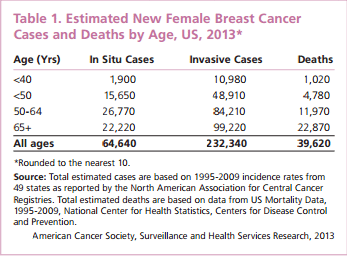Breast Cancer 2014: Latest Update

It’s October 2014 and “Breast Cancer Awareness Month”. At AdventureWomen, we know that breast cancer is a disease which ALL women are concerned with, whether or not they have experienced it directly either themselves or via friends and/or family members. Being a 3 time breast cancer survivor myself, I wanted to share some of the latest updates around detection/incidence and treatment of breast cancer. Even though we still have a long way to go for a cure, we are proud at AdventureWomen to meet so many women who use their resilience to overcome the odds, everyday, in lots of different ways.

Breast Cancer: The Latest Facts (from the Third Annual Breast Cancer Deadline 2020® Progress Report)
- Worldwide, breast cancer accounts for nearly a quarter of all cancers in women.
- In the U.S., the chance of a woman developing breast cancer during her lifetime has increased to 1 in 8 today and is diagnosed in approximately 300,000 women annually.
- 50 to 75% of breast cancers begin in the milk ducts and 10 to 15% in the lobules with a few more in other breast tissues. Non-invasive breast cancer (also known as ductal carcinoma in situ or DCIS) occurs when abnormal cells grow inside the milk ducts but have not spread to nearby tissue or beyond. Approximately 21% of breast cancer cases are In Situ vs Invasive:

- DCIS is non-invasive, but without treatment, about 20 to 30 percent of low grade DCIS will progress to invasive breast cancer and higher grade DCIS may be more likely to turn into invasive cancer if left untreated. At this time, health care providers cannot predict which cases of DCIS will progress to invasive breast cancer and which will not.
- NCI reports that the five-year breast cancer survival is 98% for localized disease. Survival rates are skewed, however, by the increased frequency of screening. The women are screened, the more cancer is detected and the more women will be still alive at five years (since they were not going to die of breast cancer in that time frame even if they had not been screened).
- An estimated 20% to 30% of women diagnosed with invasive breast cancer will have a recurrence of their disease and may go on to die of the disease despite having been included in 5 year survival statistics.
Recent Breast Cancer Trends: Incidence, Over Diagnosis and Treatments
- While the incidence of early-stage breast cancer increased significantly in the period between 1976 and 2008, the incidence of late-stage disease decreased only slightly and the incidence of metastatic breast cancer did not change at all.
- More data continues to be collected regarding the magnitude of over-diagnosis due to mammography screening and the resulting harms. One study estimates the rate of over-diagnosis from screening to be between 15% and 25%. The harms from over-diagnosis are not insignificant. The British Medical Journal published estimates from Dr. Michael Baum this year that for every breast cancer death avoided from screening, an additional one to three deaths can be expected as a result of radiotherapy for those over-diagnosed, because of their increased risk of dying of heart disease and lung cancer.
- For decades, breast cancer treatment has included surgery, radiation therapy, chemotherapy, and/or hormonal therapy, and within the past 15 years, targeted therapy. We now divide breast cancer into subtypes, based on the biology of the tumor and we have made some progress toward developing treatments targeted to different subtypes. But the majority of women with breast cancer still receive the same treatment as though all breast cancers were the same.
- U.S. breast cancer mortality has been declining but only slightly. In 1991, in the United States, 119 women died of breast cancer every day. This year, that number is estimated to be 108.5. In 2013, 39,620 women and 410 men will die of the disease. That is one death every 14 minutes. Women do not die of primary breast cancer. More than 90% of breast cancer deaths are due to the spread of the disease to other parts of the body.
- Lots of funding but recent declines. The Federal Government remains the largest funder of breast cancer research in the U.S. In 2012, NCI directed $602 million to breast cancer research, a decline of almost $30 million from the level in 2010. Department of Defense (DOD) Breast Cancer Research Program (BCRP) funding also saw a decrease of more than 22% from 2010 levels (although the proportion of research funds coded in the area of breast cancer progression and metastasis increased during that same period). The largest private funder of breast cancer research is Susan G. Komen, which awarded $42 million in grants in 2013, a 26% decrease from 2011 grant funding.
- In 2010, the National Breast Cancer Coalition set a deadline to know how to end breast cancer by January 1, 2020—Breast Cancer Deadline 2020®.
To applaud the efforts of breast cancer survivors everywhere, we wanted to end this post with some links to inspirational stories about breast cancer survivors living their lives with strength, confidence and a positive spirit of hope that one day, we will find a cure.


